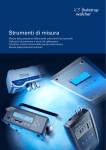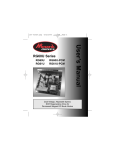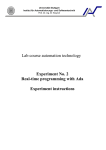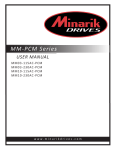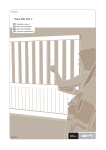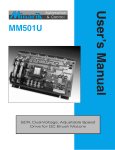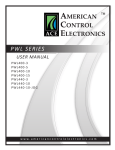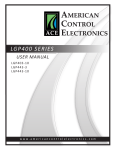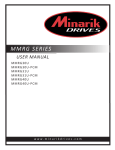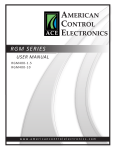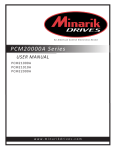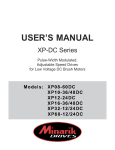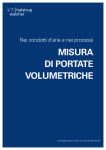Download Minarik DC Drives - LVBL Series
Transcript
LV B L S E RI ES USER MANUAL LVBL02- 24AC /D C www.minarikdrives.com Dear Valued Consumer: Congratulations on your purchase of the LVBL Series drive. This User Manual was created for you to get the most out of your new device and assist with the initial setup. Please visit www.minarikdrives.com to learn more about our other drives. Thank you for choosing Minarik Drives! © 2014 Minarik Drives. All rights reserved. No part of this document may be reproduced or transmitted in any form without written permission from Minarik Drives. The information and technical data in this document are subject to change without notice. Minarik Drives makes no warranty of any kind with respect to this material, including, but not limited to, the implied warranties of its merchantability and fitness for a given purpose. Minarik Drives assumes no responsibility for any errors that may appear in this document and makes no commitment to update or to keep current the information in this document. LVBL Series Safety First! SAFETY WARNINGS ! WARNING! Text in gray boxes denote important safety tips or warnings. Please read these instructions carefully before performing any of the procedures contained in this manual. • DO NOT INSTALL, REMOVE, OR REWIRE THIS EQUIPMENT WITH POWER APPLIED. Have a qualified electrical technician install, adjust and service this equipment. Follow the National Electrical Code and all other applicable electrical and safety codes, including the provisions of the Occupational Safety and Health Act (OSHA), when installing equipment. • Reduce the chance of an electrical fire, shock, or explosion by using proper grounding techniques, over-current protection, thermal protection, and enclosure. Follow sound maintenance procedures. ! WARNING! It is possible for a drive to run at full speed as a result of a component failure. Minarik Drives strongly recommends the installation of a master switch in the main power input to stop the drive in an emergency. i LVBL Series Table of Contents Section 1. Regenerative Drives............................................. 1 Section 2. Specifications...................................................... 2 Section 3. Dimensions.. ........................................................ 3 Section 4. Installation. . ........................................................ 4 Mounting...................................................................................... 4 Speed Adjust Potentiometer. . ................................................. 5 Wiring........................................................................................... 6 Shielding Guidelines.............................................................. 7 Line Fusing............................................................................ 7 Connections.................................................................................. 8 Quick Disconnect Terminal Block............................................ 8 Power Input. . ......................................................................... 9 Motor.. .................................................................................. 9 Motor Hall Effect Sensors....................................................... 9 Speed Adjust Potentiometer. . ................................................10 Analog Input Signal...............................................................10 Direction Switch...................................................................10 Section 5. Operation. . ........................................................ 12 Before Applying Power..................................................................12 Select Switches.............................................................................13 Hall Effect Sensor Spacing Select (SW501). . ............................13 Startup.........................................................................................14 Starting and Stopping Methods.....................................................15 Line Starting and Stopping....................................................15 Regenerative Brake to Minimum Speed..................................15 Section 6. Calibration........................................................ 16 Minimum Speed (MIN SPEED)........................................................17 Maximum Speed (MAX SPEED). . .....................................................17 ii LVBL Series Section 7.Application Notes................................................ 18 Multiple Fixed Speeds...................................................................18 Adjustable Speeds Using Potentiometers In Series . . ........................19 Independent Adjustable Speeds.. ...................................................20 RUN/JOG Switch...........................................................................21 Leader-Follower Application..........................................................22 Single Speed Potentiometer Control Of Multiple Drives..................23 Section 8. Diagnostic LEDs.. ................................................ 24 Section 9. Troubleshooting. . ............................................... 25 Before Troubleshooting.................................................................25 Section 10. Accessories & Replacement Parts...................... 28 Unconditional Warranty.. .................................................... 29 iii LVBL Series List of Figures Figure Figure Figure Figure Figure Figure Figure Figure Figure Figure Figure Figure Figure iv 1 2 3 4 5 6 7 8 9 10 11 12 13 Four Quadrant Operation................................................... 1 LVBL02-24AC/DC Dimensions.............................................. 3 Speed Adjust Potentiometer............................................... 5 Quick Disconnect Terminal Block.. ....................................... 8 LVBL02-24AC/DC Connections. . ..........................................11 Hall Effect Sensor Spacing Select Location..........................13 Multiple Fixed Speeds.......................................................18 Adjustable Speeds Using Potentiometers in Series..............19 Independent Adjustable Speeds. . .......................................20 RUN/JOG Switch . . ................................................................ 21 Leader-Follower Application..............................................22 Single Speed Potentiometer Control of Multiple Drives. . .....23 Diagnostic LED Locations...................................................24 LVBL Series Section 1. Regenerative Drives Most non-regenerative, variable speed, DC drives control current flow to a motor in one direction. The direction of current flow is the same direction as the motor rotation. Non-regenerative drives operate in Quadrant I, and also in Quadrant III if the drive is reversible (see Figure 1). Motors must stop before reversing direction. Unless dynamic braking is used, non regenerative drives cannot decelerate a load faster than coasting to a lower speed. Quadrant II Quadrant I Quadrant III Quadrant IV MOTOR ROTATION MOTOR TORQUE NOTE: ARROWS IN SAME DIRECTION = MOTOR ACTION ARROWS IN OPPOSITE DIRECTION = REGENERATIVE ACTION Regenerative drives operate in two additional quadrants: Quadrant II and Quadrant Figure 1. Four Quadrant Operation IV. In these quadrants, motor torque is in the opposite direction of motor rotation. This allows regenerative drives to reverse a motor without contractors or switches, to control an overhauling load, and to decelerate a load faster than it would to coast to a lower speed. 1 LVBL Series Section 2. Specifications Model Continuous Armature Current (ADC) Peak Armature Current (ADC) Armature Voltage Range (VDC) HP Range 2 3* 0 - 24 1/100 - 1/44 LVBL02-24AC/DC * Peak armature current for less than 1 second. AC Input Voltage 24 - 36 VAC ± 10%, 50/60 Hz, single phase DC Input Voltage 24 - 48 VDC ± 10% Armature Voltage Range Acceleration & Deceleration Time Analog Input Signal Range Input Impedance Form Factor Load Regulation Speed Range Vibration Ambient Temperature Range 2 0 - 24 VDC 0.5 seconds 0 - 2 VDC (Isolated) 60K ohms 1.05 3% base speed or better 60:1 0.5G maximum (0 - 50 Hz) 0.1G maximum (> 50 Hz) 0° - 40° C LVBL Series Section 3. Dimensions Q502 Q501 1.10 [28] Q504 Q503 IC505 IC504 Q506 IC506 Q505 IC507 D506 1.75 [44] Y501 C503 C502 TRIP POWER IL501 L502 IL502 3.58 [91] IC501 D501 L501 0.188 [5] SW501 120 - 60 C501 IC503 D503 D502 D505 D504 1 0.25 [6] INPUT 2 DIR S1 S2 S3 HA J501 HB HC COM +5V PH-A PH-B PH-C 3.80 [97] 4.30 [109] 1.75 [44] 0.96 [24] ALL DIMENSIONS IN INCHES [MILLIMETERS] Figure 2. LVBL02-24AC/DC Dimensions 3 LVBL Series Section 4. Installation ! WARNING! Do not install, rewire, or remove this control with input power applied. Failure to heed this warning may result in fire, explosion, or serious injury. Make sure you read and understand the Safety Precautions on page i before attempting to install this product. Mounting • Drive components are sensitive to electrostatic discharge. Avoid direct contact with the circuit board. Hold the drive by the heat sink only. • Protect the drive from dirt, moisture, and accidental contact. • Provide sufficient room for access to the terminals and calibration trim pots. • Mount the drive away from heat sources. Operate the drive within the specified ambient operating temperature range. • Prevent loose connections by avoiding excessive vibration of the drive. • Mount the drive with its board in either a horizontal or vertical plane. Six 0.19” (5 mm) wide slots in the chassis accept #8 pan head screws. Fasten either the large base or the narrow flange of the chassis to the subplate. • The chassis does not need to be earth grounded. If you choose to ground the chassis, use a star washer beneath the head of at least one of the mounting screws to penetrate the anodized surface and to reach bare metal. 4 LVBL Series Speed Adjust Potentiometer ! WARNING! Be sure that the potentiometer tabs do not make contact with the potentiometer’s body. Grounding the input will cause damage to the drive. If using a remote potentiometer with a chassis drive, mount the speed adjust potentiometer through a 0.38 in. (10 mm) hole with the hardware provided (Figure 3). Install the circular insulating disk between the panel and the 10K ohm speed adjust potentiometer. Twist the speed adjust potentiometer wire to avoid picking up unwanted electrical noise. If the speed adjust potentiometer wires are longer than 18 in. (46 cm), use shielded cable. Keep the speed adjust potentiometer wires separate from power leads (INPUT 1, INPUT 2, PH A, PH B, PH C). MOUNT THROUGH A 0.38 IN. (10 MM) HOLE CW WIPER CCW NUT STAR WASHER SPEED ADJUST POTENTIOMETER INSULATING DISK POT TAB ASSIGNMENTS PANEL Figure 3. Speed Adjust Potentiometer 5 LVBL Series Wiring ! WARNING! Do not install, rewire, or remove this control with input power applied. Failure to heed this warning may result in fire, explosion, or serious injury. To prevent the risk of injury or fatality, avoid direct contact with the printed circuit board or with circuit elements. Do not disconnect any of the motor leads from the drive unless power is removed or the drive is disabled. Opening any one motor lead while the drive is running may destroy the drive. This product does not have internal solid state motor overload protection. It does not contain speed-sensitive overload protection, thermal memory retention or provisions to receive and act upon signal from remote devices for over temperature protection. If motor over protection is needed in the end-use product, it needs to be provided by additional equipment in accordance with NEC standards. • Use 18 - 24 AWG wire for logic wiring. Use 10 - 12 AWG wire for power line and motor wiring. 6 LVBL Series Shielding Guidelines ! WARNING! Under no circumstances should power and logic level leads be bundled together. Induced voltage can cause unpredictable behavior in any electronic device, including motor controls. As a general rule, Minarik Drives recommends shielding of all conductors. If it is not practical to shield power conductors, it is recommended to shield all logic-level leads. If shielding of all logic-level leads is not practical, the user should twist all logic leads with themselves to minimize induced noise. It may be necessary to earth ground the shielded cable. If noise is produced by devices other than the drive, ground the shield at the drive end. If noise is generated by a device on the drive, ground the shield at the end away from the drive. Do not ground both ends of the shield. If the drive continues to pick up noise after grounding the shield, it may be necessary to add AC line filtering devices, or to mount the drive in a less noisy environment. Logic wires from other input devices, such as motion controllers and PLL velocity controllers, must be separated from power lines in the same manner as the logic I/O on this drive. Line Fusing The drives should be fused for protection. Use a fast acting fuse rated for 50V or higher and 200% of maximum armature current. 7 LVBL Series Connections Quick-Disconnect Terminal Block The quick-disconnect terminal block is composed of a header block and terminal plug (Figure 4). To use the quick-disconnect terminal block: 1. Carefully pull terminal plug from header block. 2. With a small flat-head screwdriver, turn terminal plug screw counterclockwise to open wire clamp. 3. Insert stripped wire into the large opening in front of the plug. 4. Turn the terminal plug screw clockwise to clamp the wire. 5. Repeat steps 2–4 for each terminal until all connections are made. 6. Insert plug into header until securely fastened. Figure 4. Quick-Disconnect Terminal Block 8 LVBL Series ! Do not connect this equipment with power applied. Failure to heed this warning may result in fire, explosion, or serious injury. WARNING! Minarik Drives strongly recommends the installation of a master power switch in the voltage input line, as shown in Figure 5 (page 11). The switch contacts should be rated at a minimum of 200% of motor nameplate current and 50 volts. Power Input Connect the AC line or DC power supply leads to terminals INPUT 1 and INPUT 2. It is recommended to use a single-throw, double-pole master power switch. The switch should be rated at a minimum of 50 volts and 200% of motor current. Refer to Figure 5 on page 11. Motor Connect a DC brushless motor to terminals PH A, PH B, and PH C, as shown in Figure 5 on page 11. Ensure that the motor voltage rating is consistent with the drive’s output voltage. Motor Hall Effect Sensors The LVBL02-24AC/DC runs brushless motors with nulled hall effect sensors (60° or 120° electrical spacing). Hall effect sensors are not allowed to be advanced or retarded. To reverse motor rotation, the LVBL02-24AC/DC switches the hall effect sensor sequence, eliminating the need to switch motor leads. Connect the hall effect sensors to terminals HA, HB, and HC as shown in Figure 5 on page 11. 9 LVBL Series Speed Adjust Potentiometer Use a 10K ohm, 1/4 W potentiometer for speed control. Connect the counter-clockwise end of the potentiometer to S1, the wiper to S2, and the clockwise end to S3. If the potentiometer works inversely of the desired functionality (e.g. to increase motor speed you must turn the potentiometer counterclockwise), power off the drive and swap the S1 and S3 connections. Refer to Figure 5 on page 11. Analog Input Signal Instead of using a speed adjust potentiometer, the drive may be wired to follow an analog input voltage signal that is isolated from earth ground. Connect the signal common (–) to S1. Connect the signal reference (+) to S2. Make no connection to S3. A potentiometer can be used to scale the analog input voltage. An interface device, such as Minarik Drives model PCM4, may be used to scale and isolate an analog input voltage. An analog input voltage range of 0–2 VDC is required to produce an armature voltage range of 0–24 VDC. Direction Switch A single-pole, single-throw switch can be used as a reversal switch. Connect the switch to terminals S1 and DIR. Close the switch to reverse the motor. Open the switch to return the motor back to it’s original direction. Refer to Figure 5 on page 11. 10 LVBL Series HEADER BLOCK 1 EMERGENCY STOP SWITCH 2 DIR S1 S2 S3 HA INPUT 1 2 DIR S1 S2 S3 HA HB HC COM +5V PH-A PH-B PH-C PH-B PH-C TERMINAL PLUG HB HC COM +5V PH-A FUSE INPUT VOLTAGE 24V AC/DC DIRECTION SWITCH OPEN = FORWARD CLOSE = REVERSE cw 10K OHM SPEED ADJUST POTENTIOMETER 3-PHASE BRUSHLESS DC MOTOR 1 AMP MAX @24V 3-PHASE RMS RUN STOP RUN/STOP SWITCH OPEN = RUN CLOSE = STOP Figure 5. LVBL02-24ACDC Connections 11 LVBL Series Section 5. Operation ! WARNING! Change voltage switch settings only when the drive is disconnected from AC line voltage. Make sure both switches are set to their correct position. If the switches are improperly set to a lower voltage position, the motor will not run at full voltage and may cause damage to the transformer. If the switches are improperly set to a higher voltage position, the motor will overspeed, which may cause motor damage, or result in bodily injury or loss of life. Dangerous voltages exist on the drive when it is powered. BE ALERT. High voltages can cause serious or fatal injury. For your safety, use personal protective equipment (PPE) when operating this drive. If the motor or drive does not perform as described, disconnect the input power voltage immediately. Refer to the Troubleshooting section, page 25, for further assistance. Before Applying Power 1. Verify that no foreign conductive material is present on the printed circuit board. 2. 12 Ensure that all switches are properly set. LVBL Series Select Switches Hall Effect Sensor Spacing Select (SW501) Set the hall effect sensor spacing select switch to 60° if the hall effect sensors are at 60° electrical seperation, or to 120° if the hall effect sensors are at 120° electrical seperation. Q502 Q501 Q504 Q503 IC505 IC504 Q506 IC506 Q505 IC507 IC501 D501 L501 SW501 120 - 60 C501 D506 C502 TRIP POWER IL501 Y501 C503 IL502 L502 Hall Effect Sensor Spacing Select (SW501) IC503 D503 D502 D505 D504 1 INPUT 2 DIR S1 S2 S3 HA J501 HB HC COM +5V PH-A PH-B PH-C Figure 6. Hall Effect Sensor Spacing Select Location 13 LVBL Series Startup 1. Turn the speed adjust potentiometer or input voltage signal to minimum speed. If using a Run/Stop switch, set it to Run. If using a direction switch, set it for the desired direction. 2. Apply the input power voltage. 3. Slowly advance the speed adjust potentiometer clockwise (CW) or increase the input voltage signal. The motor slowly accelerates as the potentiometer is turned CW or as the input voltage signal is increased. Continue until the desired speed is reached. 4. 14 Remove the input power voltage from the drive to coast the motor to a stop. LVBL Series Starting and Stopping Methods ! WARNING! Regenerative braking, coasting to a stop, or decelerating to minimum speed is recommended for frequent starts and stops. Do not use any of these methods for emergency stopping. They may not stop a drive that is malfunctioning. Removing AC line power (both lines) is the only acceptable method for emergency stopping. For this reason, Minarik Drives strongly recommends installing an emergency stop switch on both AC line inputs (see Figure 5 on page 11). Frequent starting and stopping can produce high torque. This may cause damage to motors, especially gearmotors that are not properly sized for the application. Automatic Restart Upon Power Restoration All drives automatically run to set speed when power is applied and the Run/Stop switch is opened. Line Starting and Stopping Line starting and stopping (applying and removing AC line voltage) is recommended for infrequent starting and stopping of a drive only. When AC line voltage is applied to the drive, the motor accelerates to the speed set by the speed adjust potentiometer or analog signal. When AC line voltage is removed, the motor coasts to a stop. Regenerative Brake to Minimum Speed If using a speed adjust potentiometer, connect a single-pole, singlethrow switch between terminals S1 and S2. Closing the switch will regeneratively brake the motor to minimum speed. Opening the switch will allow the motor to run at a speed set by the speed adjust potentiometer. Refer to Figure 5 on page 11 for wiring diagram. 15 LVBL Series Section 6. Calibration ! WARNING! Dangerous voltages exist on the drive when it is powered. When possible, disconnect the voltage input from the drive before adjusting the trim pots. If the trim pots must be adjusted with power applied, use insulated tools and the appropriate personal protection equipment. BE ALERT. High voltages can cause serious or fatal injury. LVBL series drives have user-adjustable trim pots. Each drive is factory calibrated to its maximum current rating. Readjust the calibration trim pot settings to accommodate lower current rated motors. All adjustments increase with CW rotation, and decrease with CCW rotation. Use a non-metallic screwdriver for calibration. Each trim pot is identified on the printed circuit board. 16 LVBL Series Minimum Speed (MIN SPEED) The MIN SPEED setting determines the minimum motor speed when the speed adjust potentiometer or input voltage signal is set for minimum speed. To calibrate MIN SPEED: 1. Set the MIN SPEED trim pot full CCW. 2. Set the speed adjust potentiometer or input voltage signal for minimum speed. 3. Adjust MIN SPEED until the desired minimum speed is reached. Maximum Speed MAX SPEED The MAX SPEED setting determines the maximum motor speed when the speed adjust potentiometer or input voltage signal is set for maximum speed. To calibrate MAX SPEED: 1. Set the MAX SPEED trim pot full CCW. 2. Set the speed adjust potentiometer or input voltage signal for maximum speed. 3. Adjust MAX SPEED until the desired maximum speed is reached. 17 LVBL Series Section 7.Application Notes Multiple Fixed Speeds Replace the speed adjust potentiometer with a series of resistors with a total series resistance of 10K ohms. Add a single pole, multi-position switch with the correct number of positions for the desired number of fixed speeds. R1 S3 R2 S2 R3 S1 TOTAL SERIES RESISTANCE 10K OHMS R4 Figure 7. Multiple Fixed Speeds 18 LVBL Series Adjustable Speeds Using Potentiometers In Series Replace the speed adjust potentiometer with a series of resistors with a total series resistance of 10K ohms. Add a single pole, multi-position switch with the correct number of positions for the desired number of fixed speeds. CW S3 HIGH SPEED 5K OHM LOW SPEED CW S2 S1 5K OHM Figure 8. Adjustable Speeds Using Potentiometers In Series 19 LVBL Series Independent Adjustable Speeds Replace the speed adjust potentiometer with a single pole, multiposition switch, and two or more potentiometers in parallel, with a total parallel resistance of 10K ohms. Figure 9 shows the connection of two independent speed adjust potentiometers that can be mounted at two separate operating stations. S3 SPEED 2 CW CW SPEED 1 20K OHM 20K OHM S2 S1 Figure 9. Independent Adjustable Speeds 20 LVBL Series RUN/JOG Switch Connect the RUN/JOG switch and the JOG pushbutton as shown in Figure 10. When the RUN/JOG switch is set to JOG, the motor decelerates to zero speed. Press the JOG pushbutton to jog the motor. Return the RUN/ JOG switch to RUN for normal operation. S3 CW S2 10K OHM SPEED ADJUST POTENTIOMETER S1 RUN JOG JOG PUSHBUTTON Figure 10. RUN/JOG Switch 21 LVBL Series Leader-Follower Application In this application, use a PCM4 to monitor the speed of the leader motor. The PCM4 isolates the leader motor from the follower drive, and outputs a voltage proportional to the leader motor armature voltage. The follower drive uses this voltage reference to set the speed of the follower motor. An optional ratio potentiometer may be used to scale the PCM4 output voltage. MOTOR A2 (+) 2 9 (+) A1 Leader Drive PCM4 8 7 (-) TB501 S2 (-) 1 TB502 S1 10K Ohm (optional) Figure 11. Leader-Follower Application 22 Follower Drive LVBL Series Single Speed Potentiometer Control Of Multiple Drives Multiple drives can be controlled with a single speed adjust potentiometer using a USIM-8 at the input of each drive to provide isolation. Optional ratio potentiometers can be used to scale the USIM-8 output voltage, allowing independent control of each drive. 10K Ohms ratio pot A (optional) 10K Ohms S3 + S2 1 S2 S1 - S1 + Drive A A1 ratio pot B (optional) 10K Ohms A1 2 S2 - S1 Motor A A2 Drive B Motor B A2 USIM-8 + ratio pot H (optional) 10K Ohms A1 8 S2 - S1 Drive H Motor H A2 Figure 12. Single Speed Potentiometer Control of Multiple Drives 23 LVBL Series Section 8. Diagnostic LEDs The LVBL02-24AC/DC is equipped with two diagnostic LEDs: • Current Limit (TRIP): Red LED lights whenever the drive reaches current limit. If the drive is at current limit for 1 second, the drive will disable. To reset, remove power from the drive for 30 seconds, then restart. • Power (POWER): Green LED lights whenever drive is applying voltage out to the motor. The LED will blink proportional to motor speed (the faster the motor speed, the faster the blink rate). Q502 Q501 Q504 Q503 IC505 IC504 Q506 IC506 Q505 IC507 IC501 D501 L501 SW501 120 - 60 C501 D506 TRIP POWER C502 IL501 Y501 C503 IL502 L502 IC503 D503 D502 D505 D504 1 INPUT 2 DIR S1 S2 S3 HA J501 HB HC COM +5V PH-A PH-B PH-C Trip LED Figure 13. Diagnostic LED Locations 24 Power LED LVBL Series Section 9. Troubleshooting ! WARNING! Dangerous voltages exist on the drive when it is powered. When possible, disconnect the drive while troubleshooting. High voltages can cause seroius or fatal injury. Before Troubleshooting Perform the following steps before starting any procedure in this section: 1. Disconnect the source power from the drive. 2. Check the drive closely for damaged components. 3. Check that no conductive or other foreign material has become lodged on the printed circuit board. 4. Verify that every connection is correct and in good condition. 5. Verify that there are no short circuits or grounded connections. 6. Check that the drive’s rated armature is consistent with the motor ratings. For additional assistance, contact your local Minarik Drives distributor or the factory direct: (800) MINARIK or FAX: (800) 394-6334 25 LVBL Series PROBLEM Line fuse blows. SUGGESTED SOLUTIONS 1. Check that the line fuse is correct for the motor size. 2. Motor cable is shorted to ground. 2. Check motor cable for shorts. 3. Nuisance tripping caused by a combination of ambient conditions and high-current spikes (i.e. reversing). 3. Add a blower to cool the drive components, resize motor and drive for actual load demand, or check for incorrectly aligned mechanical components or “jams”. 1. Speed adjust potentiometer or input voltage signal is set to zero speed. 1. Increase the speed adjust potentiometer setting or input voltage signal. 2. Drive is in current limit. 2. Verify that the motor is not jammed. 3. Drive is not receiving AC line voltage. 5. Apply AC line voltage. 4. Motor is not connected. 6. Remove power. Connect the motor to PH A, PH B, PH C. Reapply power. Motor does not stop when the speed adjust potentiometer is full CCW. 1. MIN SPEED setting is too low. 1. Increase MIN SPEED setting. 2. Noise on logic wires. 2. Place a .01 μF capacitor across terminals S0 and S2. Motor runs too fast. 1. MAX SPEED is set too high. 1. Calibrate MAX SPEED. Motor will not reach the desired speed. 1. MAX SPEED setting is too low. 1. Increase MAX SPEED setting. 2. Motor is overloaded. 2. Check motor load. Resize the motor and drive if necessary. Line fuse does not blow, but the motor does not run. 26 POSSIBLE CAUSE 1. Line fuse is the wrong size. LVBL Series PROBLEM Motor pulsates or surges under load. POSSIBLE CAUSE 1. Motor bouncing in and out of current limit. SUGGESTED SOLUTIONS 1. Make sure motor is not undersized for load. 27 LVBL Series Section 10. Accessories & Replacement Parts Displays Closed Loop................................................................................. DLC600 Open Loop....................................................................................... VT-8 Kits Potentiometer & Connector Pot Kit.................................................................................. 202-0088 Fuse 1.5 - 5 Amp Fuse Kit............................................................. 050-0066 1 - 8 Amp Fuse Kit with Pico Fuse........................................ 050-0068 Logic Cards Current Sensing 5 Amps..................................................................................... CSC1-5 Isolation Cards Unidirectional, 8 outputs........................................................ USIM-8 Bidirectional, 1 output............................................................... PCM4 28 LVBL Series Unconditional Warranty A. Warranty Minarik Drives warrants that its products will be free from defects in workmanship and material for twelve (12) months or 3000 hours, whichever comes first, from date of manufacture thereof. Within this warranty period, Minarik Drives will repair or replace, at its sole discretion, such products that are returned to Minarik Drives, 14300 De La Tour Drive, South Beloit, Illinois 61080 USA. This warranty applies only to standard catalog products, and does not apply to specials. Any returns of special controls will be evaluated on a case-by-case basis. Minarik Drives is not responsible for removal, installation, or any other incidental expenses incurred in shipping the product to and from the repair point. B. Disclaimer The provisions of Paragraph A are Minarik Drives’s sole obligation and exclude all other warranties of merchantability for use, expressed or implied. Minarik Drives further disclaims any responsibility whatsoever to the customer or to any other person for injury to the person or damage or loss of property of value caused by any product that has been subject to misuse, negligence, or accident, or misapplied or modified by unauthorized persons or improperly installed. C. Limitations of Liability In the event of any claim for breach of any of Minarik Drives’s obligations, whether expressed or implied, and particularly of any other claim or breach of warranty contained in Paragraph A, or of any other warranties, expressed or implied, or claim of liability that might, despite Paragraph B, be decided against Minarik Drives by lawful authority, Minarik Drives shall under no circumstances be liable for any consequential damages, losses, or expenses arising in connection with the use of, or inability to use, Minarik Drives’s product for any purpose whatsoever. An adjustment made under warranty does not void the warranty, nor does it imply an extension of the original 12-month warranty period. Products serviced and/or parts replaced on a no-charge basis during the warranty period carry the unexpired portion of the original warranty only. If for any reason any of the foregoing provisions shall be ineffective, Minarik Drives’s liability for damages arising out of its manufacture or sale of equipment, or use thereof, whether such liability is based on warranty, contract, negligence, strict liability in tort, or otherwise, shall not in any event exceed the full purchase price of such equipment. Any action against Minarik Drives based upon any liability or obligation arising hereunder or under any law applicable to the sale of equipment or the use thereof, must be commenced within one year after the cause of such action arises. 29 w w w.minarikdrives.com 1430 0 DE LA TOUR DRIV E SO U TH BELOIT, IL 61080 (800) MINA RIK 250-0261 Rev 4




































